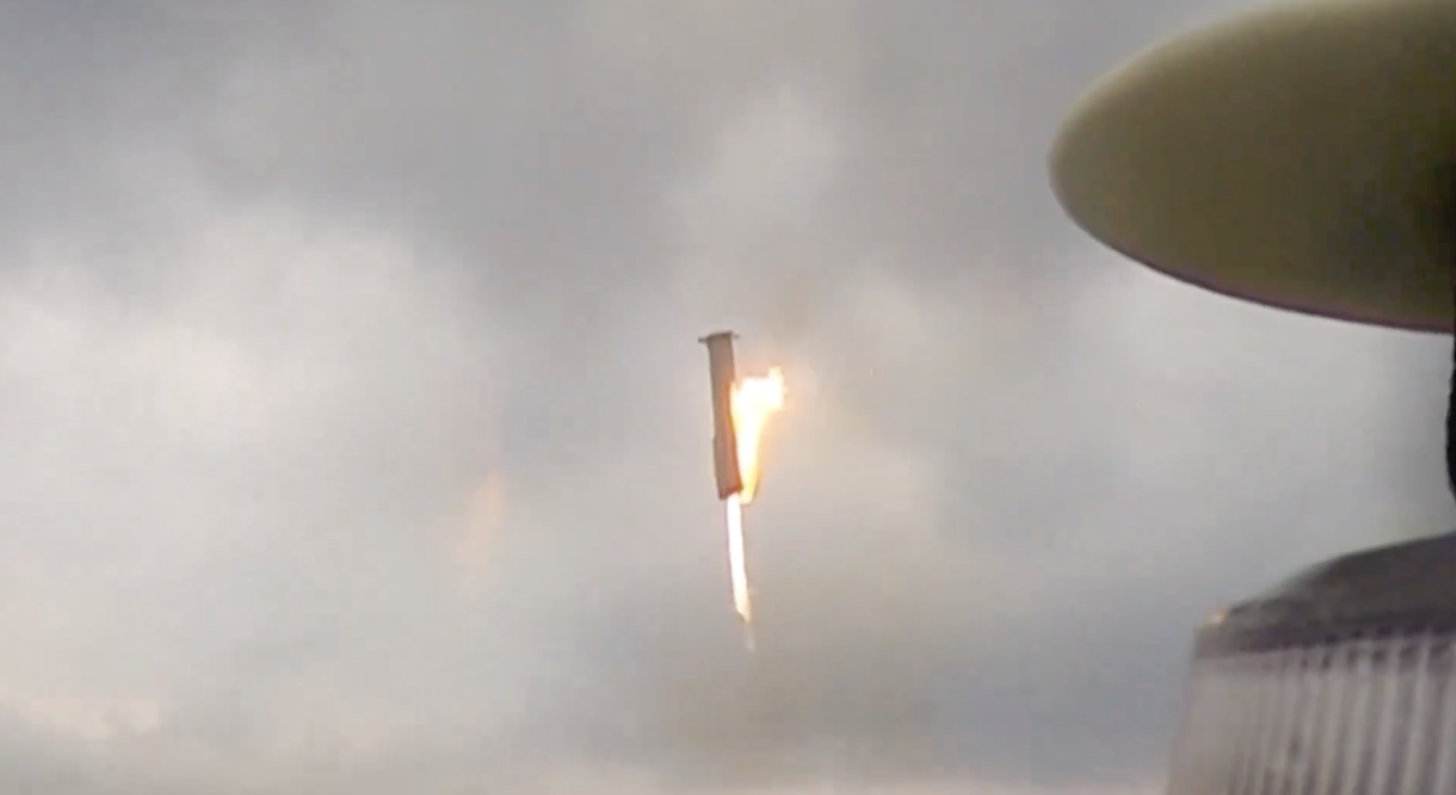
SpaceX's Starship rocket as it rises to the skies during IFT-4. Image: SpaceX/X
Die Starship-Rakete von SpaceX steigt während IFT-4 in den Himmel. Bild: SpaceX/X
In a live stream on X this weekend, Elon Musk continued to share details for SpaceX's fourth Starship test flight and future missions. Starship is the world's largest rocket, and its full stack lifted off for the fourth time in Texas last week. This was the fourth Starship test flight, and it was also the most successful test to date since both the booster and the upper stage spacecraft were able to softly splashdown in the ocean. According to Musk, ahead of flight five, SpaceX will add beefier heat shield tiles on the rocket, and the next flight could take place as soon as next month.
In einem Livestream auf X an diesem Wochenende teilte Elon Musk weiterhin Details zum vierten Starship-Testflug von SpaceX und zukünftigen Missionen mit. Starship ist die größte Rakete der Welt und ihr gesamter Raketenturm hob letzte Woche zum vierten Mal in Texas ab. Dies war der vierte Starship-Testflug und zugleich der bislang erfolgreichste Test, da sowohl die Trägerrakete als auch die Oberstufe des Raumschiffs sanft im Meer auftauchen konnten. Laut Musk wird SpaceX vor Flug fünf stärkere Hitzeschildkacheln an der Rakete anbringen, und der nächste Flug könnte bereits im nächsten Monat stattfinden.
SpaceX Is Adding Beefier Heat Shield Tiles On Starship Ahead Of Flight 5 Says Musk
The fourth Starship test flight was the second such launch in 2024, and it sped up the turnaround time between launches. SpaceX had to deal with the devastating impact of the first test on the launch pad last year, which resulted in a detailed regulatory process that delayed the second flight. Now, with these hurdles behind it, the firm can rapidly conduct test flights to test its technologies and gather data.
SpaceX fügt vor Flug 5 kräftigere Hitzeschildkacheln auf Starship hinzu, sagt Musk. Der vierte Starship-Testflug war der zweite derartige Start im Jahr 2024 und verkürzte die Durchlaufzeit zwischen den Starts. SpaceX musste sich letztes Jahr mit den verheerenden Auswirkungen des ersten Tests auf der Startrampe auseinandersetzen, was zu einem detaillierten Regulierungsprozess führte, der den zweiten Flug verzögerte. Nachdem diese Hürden nun überwunden sind, kann das Unternehmen schnell Testflüge durchführen, um seine Technologien zu testen und Daten zu sammeln.
Consequently, Musk believes that the fifth Starship test flight will take place in a month. Speaking with viewers on an X livestream, the executive shared that the "next launch, Starship launch is probably in about a month." A key reason behind this long timeline is Starship's heat shield. As is the case with other spacecraft, Starship's heat shield is one of its most complex components. SpaceX uses thousands of tiles to build the heat shield. According to Musk, before the next flight SpaceX will upgrade the rocket's heat shield tiles.
Daher geht Musk davon aus, dass der fünfte Starship-Testflug in einem Monat stattfinden wird. Im Gespräch mit den Zuschauern eines X-Livestreams teilte die Führungskraft mit, dass „der nächste Start, der Starship-Start, wahrscheinlich in etwa einem Monat erfolgt“. Ein Hauptgrund für diese lange Zeitspanne ist der Hitzeschild von Starship. Wie bei anderen Raumfahrzeugen ist auch bei Starship der Hitzeschild eine der komplexesten Komponenten. SpaceX verwendet Tausende von Kacheln, um den Hitzeschild zu bauen. Laut Musk wird SpaceX vor dem nächsten Flug die Hitzeschildkacheln der Rakete aufrüsten.
One regular problem that Starship has faced throughout its testing history is the heat shield tiles falling off. These tiles come loose during flight and while the rocket is on the ground. Musk shared that SpaceX plans to add an additional layer under the tiles to keep the ship safe during re entry in case its tiles fall off.
Ein regelmäßiges Problem, mit dem Starship im Laufe seiner Testgeschichte konfrontiert war, ist das Herunterfallen der Hitzeschildplatten. Diese Kacheln lösen sich während des Fluges und während die Rakete am Boden steht. Musk teilte mit, dass SpaceX plant, eine zusätzliche Schicht unter den Kacheln anzubringen, um das Schiff beim Wiedereintritt zu schützen, falls seine Kacheln herunterfallen.

The Super Heavy as it descends to the water for its soft splashdown. Image: SpaceX/X
Der Super Heavy, während er ins Wasser hinabsteigt und sanft aufspritzt. Bild: SpaceX/X
"We have to take, we're gonna replace the whole heat shield on the ship. So the new heat shield tile is about twice as strong as the ones that were on the last flight," shared Musk. "So, um, and we wanna put an. .an ablative secondary structure, like basically ablative protection behind the tiles so that if a tile cracks or come loose, it doesn't cook the rocket," he added.
„Wir müssen den gesamten Hitzeschild auf dem Schiff austauschen. Die neue Hitzeschildkachel ist also etwa doppelt so stark wie die auf dem letzten Flug“, teilte Musk mit. „Also, ähm, und wir wollen eine ablative Sekundärstruktur anbringen, im Grunde genommen einen ablativen Schutz hinter den Fliesen, damit, wenn eine Fliese reißt oder sich löst, die Rakete nicht zum Kochen kommt“, fügte er hinzu.
The new tiles are "about twice as strong, or hopefully half as likely to crack or come off," and SpaceX tested the secondary ablative material in the fourth flight in the areas where the heat shield tiles were deliberately removed. This material is "like a silicone, felt ablative," which is not "good for reuse" but keeps the ship and its inhabitants safe in case the tiles fall off during or before reentry.
Die neuen Kacheln seien „ungefähr doppelt so stark oder hoffentlich halb so wahrscheinlich, dass sie reißen oder sich ablösen“, und SpaceX testete das sekundäre Ablationsmaterial im vierten Flug in den Bereichen, in denen die Hitzeschildkacheln absichtlich entfernt wurden. Dieses Material ist „wie ein Silikon-Filz-Ablativ“, das nicht „für die Wiederverwendung geeignet“ ist, aber das Schiff und seine Bewohner schützt, falls die Fliesen während oder vor dem Wiedereintritt abfallen.
According to Musk, his plans to build a self sustaining city on Mars need to get to a point were "if the ships from Earth stop coming for any reason, that the Mars city does not die out." As for the first flight to Mars, "within three years" is a reasonable estimate.
Laut Musk müssen seine Pläne zum Bau einer sich selbst tragenden Stadt auf dem Mars zu einem Punkt kommen: „Wenn die Schiffe von der Erde aus irgendeinem Grund aufhören zu kommen, stirbt die Stadt auf dem Mars nicht aus.“ Für den ersten Flug zum Mars ist „innerhalb von drei Jahren“ eine vernünftige Schätzung.
Since Earth and Mars only align every two years, a viable option could be to "send a few ships on the first Mars rendezvous" to "confirm that they can land well, and then crank it up from there, then, you know go to I don't know twenty or thirty ships in the second rendezvous, a hundred on the third and try to get to a thousand ships going to Mars every rendezvous, every two years as quickly as possible," speculated Musk.
Da sich Erde und Mars nur alle zwei Jahre angleichen, könnte eine praktikable Option darin bestehen, „ein paar Schiffe zum ersten Mars-Rendezvous zu schicken“, um „zu bestätigen, dass sie gut landen können, und dann von dort aus loszulegen, wissen Sie schon.“ Ich kenne nicht zwanzig oder dreißig Schiffe beim zweiten Rendezvous, hundert beim dritten und versuche, bei jedem Rendezvous, alle zwei Jahre, so schnell wie möglich auf tausend Schiffe zu kommen, die zum Mars fliegen“, spekulierte Musk.
As for the fifth flight, Musk reiterated that SpaceX plans to catch the booster with the launch tower. "I think Mechazilla's got a decent chance of catching the rocket, probably I don't know 50% chance," he said. Elaborating on the booster's return profile, he revealed that when "the booster will come back, it will have an impact point that's out to sea. So it'll have to steer itself towards the tower with the catch arms, and, uh, if anything is, if the booster detects that anything's wrong, it'll suicide itself into the ocean. If things are looking good, it'll steer over to the tower and the arms should be able to grab it."
Was den fünften Flug anbelangt, bekräftigte Musk, dass SpaceX plant, die Trägerrakete mit dem Startturm einzufangen. „Ich denke, Mechazilla hat eine gute Chance, die Rakete zu fangen, ich weiß es wahrscheinlich nicht, die 50-Prozent-Chance“, sagte er. Als er das Rückkehrprofil des Boosters näher erläuterte, verriet er, dass „der Booster bei seiner Rückkehr einen Aufprallpunkt auf dem Meer haben wird. Er muss sich also mit den Fangarmen auf den Turm zusteuern, und, äh, wenn.“ Wenn der Booster erkennt, dass etwas nicht stimmt, stürzt er sich ins Meer. Wenn alles gut aussieht, steuert er zum Turm und die Arme sollten ihn ergreifen können.


 Crypto News Land
Crypto News Land DogeHome
DogeHome Crypto News Land
Crypto News Land Optimisus
Optimisus Cryptopolitan_News
Cryptopolitan_News Optimisus
Optimisus Optimisus
Optimisus Optimisus
Optimisus






















